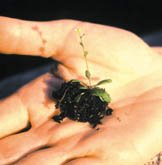First Plant Genome Thrills Biologists

An international team of scientists has published the first nearly complete genetic blueprint of a plant. Now, thale cress—a small weed related to the mustard plant—joins more than 30 bacteria, baker’s yeast, the nematode worm, the fruit fly, and the human in a growing roster of genetically decoded organisms.
Hailed by many as plant biology’s breakthrough of the decade, the unveiling of thale cress’ genome, described in a set of papers in the Dec. 14 Nature, is expected to accelerate the pace of discovery in research fields ranging from molecular medicine to agriculture.
During the past 2 decades, thale cress, or Arabidopsis thaliana, has become plant biology’s experimental favorite. Like a lab mouse, this model organism reproduces quickly and bountifully in small spaces; 1,000 of these tiny plants could thrive within the area of this page.
With only about 125 million nucleotide base pairs, Arabidopsis is much easier to study than a crop plant like the soybean, whose genome is hundreds of times larger. Moreover, Arabidopsis genes are easily incorporated into other plants, and vice-versa, for experimental studies.
“Many of the principles that have been worked out in this little plant work in the same ways in more agriculturally important plants” like corn or wheat, says Gerald R. Fink, director of the Whitehead Institute for Biomedical Research in Cambridge, Mass. So, the genetic insights gained through Arabidopsis will shed light on the inner workings of most other plant species, he says.
Thale cress also was appealing for a full-genome study because scientists had assumed its DNA contains just one copy of most genes. But during the sequencing, researchers found that nearly two-thirds of the 25,500 Arabidopsis genes are duplicates. Grouping these copies revealed about 11,600 distinct families of one or more genes.
The unexpectedly extensive gene duplication is the most intriguing discovery of the Arabidopsis sequencing project. Some scientists believe the apparent duplicates are not truly identical. “Those duplicated genes probably perform differential roles within the organism,” says Owen White of the Institute for Genomic Research (TIGR) in Rockville, Md., a coauthor of the primary Nature paper.
“There is a possibility that each one of these forms has distinct biochemical properties,” agrees his coauthor Athanasios Theologis of the Plant Gene Expression Center in Albany, Calif. Which form gets expressed may depend on the biochemistry of a cell at a given point in the plant’s development, he postulates.
Or each gene in a family may be effective in a slightly different climate, says geneticist Steve Kay of Scripps Research Institute in La Jolla, Calif.
Alternatively, Kay says, plants might have multiple copies of similar genes to ensure against DNA damage from solar radiation. If one or two copies of a gene get mutated, he reasons, there’s always a spare.
Whatever its purpose, genetic duplication “should tell us some pretty exciting things,” White says.
The international consortium that began sequencing Arabidopsis in 1996 has been depositing its new data weekly onto a Web site called GenBank (http://www.ncbi.nlm.nih.gov/Genbank/GenbankOverview.html). The researchers published the sequences of chromosomes 2 and 4 last December (SN: 12/18 & 25/99, p. 356). The papers appearing in the latest Nature describe the plant’s remaining three chromosomes. Altogether, the group reports, it has decoded 92 percent of the genome.
With so much of the genetic blueprint for Arabidopsis in hand, researchers can take a global view of plant function.
“We can now start asking much bigger questions at the genome-wide level,” says Mary Lou Guerinot, a plant biologist at Dartmouth College in Hanover, N.H. Before, scientists could study only how one gene or a small gene ensemble behaves under certain conditions. Now, she says, researchers can see an entire genetic pathway become activated and can unravel relationships among hundreds of genes.
For instance, Kay’s group has used GenBank data to study how Arabidopsis regulates the hundreds of genes that protect it from sunlight and frost damage. His group reports these findings in the Dec. 15 Science.
“The plant puts on sunscreen every morning by regulating a large number of genes in a biosynthetic pathway for compounds that are UV-protectant,” Kay says. Later, “just before dusk, the plant turns on…cold-resistant genes, and turns them off again around morning.”
Scientists predict that the sequenced Arabidopsis genome will have many practical applications, especially in agricultural engineering.
“In the past, we’ve bred for traits without knowing which genes were involved,” Guerinot says. “Now that we’re going to have the genes at our fingertips, things will probably move much faster.”
The Arabidopsis genome may also reveal more about how plants make nutrients. “It’s really going to enrich nutrition as a science,” Fink says.
Information about Arabidopsis genes could lead to less controversial genetically modified foods, Guerinot says. Instead of inserting an animal or bacterial gene into a crop plant to improve a trait like frost resistance, bioengineers may be able to use a plant gene instead.
Relative to the similar-size genomes of three other organisms—fruit fly, nematode worm, and yeast—the Arabidopsis sequence is the most accurate and complete, the researchers say. They’ve even decoded some of the gene-poor chromosomal regions called centromeres. These data may help researchers make artificial plant chromosomes, according to Theologis.
The next big project for Arabidopsis aficionados is to nail down every gene’s function. The roles of only about 1,000 of the genes—less than 10 percent—have been experimentally determined. By using computer algorithms to compare Arabidopsis sequences with those of genes from other organisms, researchers have made educated guesses about what another 55 percent of the plant’s genes do.
To confirm each gene’s role experimentally, the research community just launched a 10-year project to deactivate or overactivate each Arabidopsis gene one-by-one. The consequences of these manipulations should reveal where, when, and how each gene functions.
Some plant researchers describe the sequencing of Arabidopsis as the high point of their careers. “Every 10 years there are advances, and this is one of the greatest,” says Theologis, who has studied plant biology since 1943. “It’s a beautiful time.”